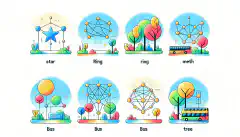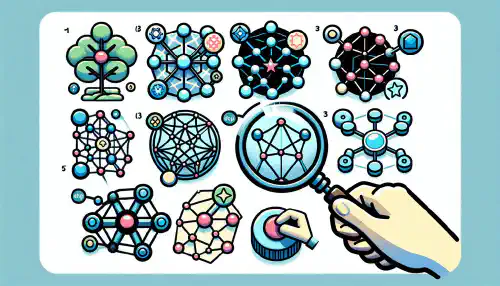Optimize Your Network: Understanding Designs & Topologies

Table of Contents
Decoding Network Designs: Types and Topologies Explained
In the world of networking, understanding different types of network designs and topologies is crucial for creating efficient and reliable networks. Network designs refer to the overall structure and layout of a network, while network topologies define the arrangement of network devices and connections. This article will delve into the various types of network designs and explore different network topologies, providing key takeaways to help you better comprehend and implement network designs in your own projects.
Key Takeaways
- Hierarchical design is a common network design approach that involves dividing a network into multiple layers or tiers.
- Mesh design provides high redundancy and fault tolerance by connecting each network device directly to every other device.
- Star design is a popular choice for small to medium-sized networks, where all devices are connected to a central hub or switch.
- Ring design connects devices in a circular loop, with each device connected to the next device in the ring.
- Bus design uses a single cable to connect all devices in the network, with each device tapping into the cable to send or receive data.
Types of Network Designs
Hierarchical Design
Hierarchical design is a network architecture that organizes devices in a hierarchical structure, with multiple layers of interconnected devices. This design is commonly used in large-scale networks, as it provides scalability, manageability, and efficient traffic flow.
In a hierarchical design, the network is divided into three main layers: the core layer, the distribution layer, and the access layer. Each layer has a specific role and function in the network.
Core layer: The core layer is responsible for high-speed data transmission between different parts of the network. It connects the distribution layer switches and provides a fast and reliable backbone for the network.
Distribution layer: The distribution layer acts as an intermediary between the core layer and the access layer. It provides routing, filtering, and policy-based services to ensure efficient traffic distribution and access control.
Access layer: The access layer is the closest layer to end devices, such as computers, printers, and servers. It provides connectivity to these devices and controls their access to the network.
A hierarchical design offers several advantages for network security. By separating the network into different layers, it allows for better control and segmentation of network traffic. This helps in isolating potential security threats and limiting their impact on the entire network. Additionally, the hierarchical structure simplifies network management and troubleshooting, making it easier for cybersecurity experts to monitor and secure the network.
To summarize, hierarchical design is a network architecture that organizes devices into layers, providing scalability, manageability, and efficient traffic flow. It consists of the core layer, distribution layer, and access layer, each with specific roles and functions. This design enhances network security by enabling better control and segmentation of network traffic, simplifying management and troubleshooting for cybersecurity experts.
Mesh Design
Mesh Design
Mesh design is a network topology where each device is connected to every other device in the network. It provides a high level of redundancy and fault tolerance, making it suitable for critical applications that require continuous connectivity. In a mesh design, data can take multiple paths to reach its destination, enhancing reliability and performance.
Mesh design is particularly beneficial in the context of cybersecurity. By creating multiple connections between devices, it becomes more challenging for an attacker to disrupt communication or compromise the network. The decentralized nature of mesh design also reduces the impact of a single point of failure, making it resilient against attacks.
In terms of encoding and decoding data, mesh design does not directly influence these processes. However, its inherent redundancy and fault tolerance contribute to the overall security and reliability of data transmission .
Star Design
Star Design
A star design is a type of network design where all devices are connected to a central hub or switch. This hub acts as a central point of control and communication for the network. The devices in a star design are connected to the hub through individual links, creating a radial pattern.
In a star design, the central hub plays a crucial role in the network’s operation. It manages the flow of data between devices, ensuring efficient communication and coordination. The hub also provides a centralized point for network administration and troubleshooting.
A star design offers several advantages. First, it provides a high level of reliability and fault tolerance. If one device fails, it does not affect the operation of other devices in the network. Second, it allows for easy scalability and expansion. New devices can be added to the network by simply connecting them to the central hub. Finally, a star design simplifies network management and troubleshooting, as the hub serves as a single point of control.
However, a star design also has some limitations. It requires more cabling compared to other network designs, as each device needs a separate link to the central hub. This can increase the cost and complexity of the network infrastructure. Additionally, the central hub can become a single point of failure. If the hub fails, the entire network may be affected.
Overall, a star design is a popular choice for small to medium-sized networks. Its centralized structure and ease of management make it suitable for various applications , including computer networks in FE Electrical.
Ring Design
Ring Design
Ring design is a network topology that forms a closed loop, where each device is connected to exactly two other devices. This design is characterized by its ability to provide redundancy and fault tolerance . In a ring design, data travels in a circular path, passing through each device until it reaches its destination. This topology is commonly used in local area networks (LANs) and can be implemented using both wired and wireless connections.
One important consideration in ring design is the presence of a token, which is passed from one device to another to control access to the network. The token ensures that only one device can transmit data at a time, preventing collisions and ensuring efficient communication. In the event of a device failure, the token is automatically passed to the next device in the ring, maintaining network connectivity.
Ring design offers several advantages, including:
Bus Design
Bus design is a type of network design where all devices are connected to a single communication line called a bus. In this design, data is transmitted in a sequential manner , with each device receiving the data and determining if it is the intended recipient. This design is commonly used in local area networks (LANs) and is known for its simplicity and cost-effectiveness.
Exploring Network Topologies

Physical Topology
Physical topology refers to the physical layout of networked devices and their connections . It focuses on the arrangement of devices and the way they are connected to each other. This aspect of network design is crucial for understanding the overall structure and functionality of a network.
Logical Topology
Logical topology refers to the way in which data is transmitted between devices in a network. It focuses on the logical connections and pathways that exist between devices, rather than the physical layout of the network. This is an important concept for cybersecurity experts as it helps in understanding how data flows within a network and how it can be secured.
Point-to-Point Topology
Point-to-Point Topology is a fundamental concept in networking .
Multipoint Topology
Multipoint Topology is a network topology where multiple devices are connected to a central hub or switch. It allows for communication between multiple devices simultaneously . This type of topology is commonly used in video conferencing systems and collaborative environments.
Hybrid Topology
Hybrid Topology is a combination of two or more different network topologies. It is designed to leverage the advantages of multiple topologies while minimizing their limitations. This type of topology is commonly used in large-scale networks where different sections of the network require different types of connections. By combining different topologies, hybrid topology provides flexibility, scalability, and robustness to the network infrastructure.
Welcome to the article section of SimeonOnSecurity’s Guides! In this section, we will be exploring network topologies and diving deep into the intricacies of different network structures. Whether you are a beginner looking to understand the basics or an experienced professional seeking advanced techniques, our guides will provide you with valuable insights and practical tutorials. Discover the best practices in network management, cybersecurity practices, and system administration. Enhance your skills and gain valuable knowledge by exploring our detailed guides. Join us on this journey of exploration and take your understanding of network topologies to the next level!
Conclusion
In conclusion, understanding the different types of network designs and topologies is essential for building and maintaining efficient and reliable networks. The hierarchical design provides a structured approach to network organization, while the mesh design offers redundancy and fault tolerance. The star design simplifies network management and troubleshooting, while the ring design ensures continuous data flow. The bus design allows for easy scalability and flexibility. When exploring network topologies, it is important to consider the physical and logical aspects, as well as the point-to-point and multipoint connections. Hybrid topologies combine different types of topologies to meet specific network requirements. By comprehending these concepts, network administrators can make informed decisions to optimize network performance and meet the evolving needs of their organizations.
Frequently Asked Questions
What is a hierarchical network design?
A hierarchical network design is a network architecture that organizes devices into multiple layers, such as core, distribution, and access layers. This design provides scalability, manageability, and fault tolerance.
What is a mesh network design?
A mesh network design is a network architecture where each device is connected to every other device in the network. This design provides redundancy and fault tolerance but can be complex to implement and manage.
What is a star network design?
A star network design is a network architecture where all devices are connected to a central hub or switch. This design simplifies connectivity and troubleshooting but can be a single point of failure.
What is a ring network design?
A ring network design is a network architecture where devices are connected in a circular loop. Data travels in one direction around the ring, and each device acts as a repeater. This design provides fault tolerance but can be affected by a single point of failure.
What is a bus network design?
A bus network design is a network architecture where all devices are connected to a single communication line called a bus. Data is broadcasted to all devices, and each device listens for its specific data. This design is simple and cost-effective but can be affected by a single point of failure.
What is a physical network topology?
A physical network topology refers to the actual layout of devices, cables, and connections in a network. Examples include star, mesh, ring, bus, and hierarchical topologies.






